Development of Numerical Modelling Techniques for a Firefighting Water Tank with an Anti-Wave Plate under Seismic Loads
Abstract
:1. Introduction
2. Literature Review
3. Numerical Modelling
3.1. Target Structure
3.2. Material Model
3.3. Loading and Boundary Conditions
3.3.1. Loading
3.3.2. Boundary Conditions
3.4. Mesh Model
3.4.1. Finite Element Method
3.4.2. Finite Volume Method
4. Numerical Results
4.1. Quasi-Static Structural Analysis
4.2. Transient Structural Analysis
4.3. One-Way FSI Analysis
4.3.1. Sloshing Analysis
4.3.2. Transient Structural Analysis
5. Conclusions
- (1)
- There was no significant difference in the level of structural responses between the quasi-static (CASE I-3) and transient (CASE II) structural analysis. However, the one-way FSI (CASE III-1) analysis, which took fluid interactions into account, exhibited a significantly larger maximum total deformation and von Mises stress than the CASE I-3 and CASE II analyses. It was found that the amount of the total deformation and von Mises stress for the PDF panel at CASE III-1 increased by 85.8% and 87.2% against CASE I-3 and 85.1% and 84.3% against CASE II. This indicates that fluid interactions must be considered to obtain high-accuracy estimates of structural responses of water tanks under seismic loads.
- (2)
- The anti-wave plate affected both the free surface behaviour and the force generated by the sloshing in the tank wall, as demonstrated by the CASE III-1 and CASE III-2 analyses. However, the effect of the anti-wave plate height was not significantly appeared between CASE III-2 and CASE III-3. This demonstrates that the anti-wave plate is capable of mitigating both the free surface motions and the forces, but a higher anti-wave plate does not guarantee a more significant effect. Therefore, the optimal height of an anti-wave plate must be systematically assessed.
- (3)
- The anti-wave plate clearly decreased the structural responses in the PDF panel, as was shown by comparing the CASE III-1, III-2, and III-3 analyses. However, the maximum von Mises stress occurred near the connection between the bottom of the PDF panel and the anti-wave plate. Therefore, while the anti-wave plate effectively mitigated structural responses, a systematic design process should be employed when using an anti-wave plate, such that a significant increase in stress at the connection is prevented.
Author Contributions
Funding
Conflicts of Interest
References
- World Wide Earthquake 2000–2021. Available online: www.usgs.gov (accessed on 26 April 2023).
- Mizutori, M.; Guha-Sapir, D. Economic Losses, Poverty & Disasters 1998–2017; Centre for Research on the Epidemiology of Disasters CRED: Brussels, Belgium; United Nations Office for Disaster Risk Reduction: Geneva, Switzerland, 2018. [Google Scholar]
- Akyildiz, H.; Unal, E. Experimental investigation of pressure distribution on a rectangular tank due to the liquid sloshing. Ocean Eng. 2005, 32, 1503–1516. [Google Scholar] [CrossRef]
- Panigrahy, P.K.; Saha, U.K.; Maity, D. Experimental studies on sloshing behavior due to horizontal movement of liquids in baffled tanks. Ocean Eng. 2009, 36, 213–222. [Google Scholar] [CrossRef]
- Jin, H.; Liu, Y.; Li, H.J. Experimental study on sloshing in a tank with an inner horizontal perforated plate. Ocean Eng. 2014, 82, 75–84. [Google Scholar] [CrossRef]
- Xue, M.A.; Zheng, J.; Lin, P.; Yuan, X. Experimental study on vertical baffles of different configurations in suppressing sloshing pressure. Ocean Eng. 2017, 136, 178–189. [Google Scholar] [CrossRef]
- Kim, S.P.; Chung, S.M.; Shin, W.J.; Cho, D.S.; Park, J.C. Experimental study on sloshing reduction effects of baffles linked to a spring system. Ocean Eng. 2018, 170, 136–147. [Google Scholar] [CrossRef]
- Yu, L.; Xue, M.A.; Jiang, Z. Experimental investigation of parametric sloshing in a tank with vertical baffles. Ocean Eng. 2020, 213, 107783. [Google Scholar] [CrossRef]
- Isaacson, M.; Premasiri, S. Hydrodynamic damping due to baffles in a rectangular tank. Can. J. Civ. Eng. 2001, 28, 608–616. [Google Scholar] [CrossRef]
- Gedikli, A.; Erguven, M.E. Evaluation of sloshing problem by variational boundary element method. Eng. Anal. Bound. Elem. 2003, 27, 935–943. [Google Scholar] [CrossRef]
- Wang, J.D.; Lo, S.H.; Zhou, D. Sloshing of liquid in rigid cylindrical container with multiple rigid annular baffles: Lateral excitations. J. Fluids Struct. 2013, 42, 421–436. [Google Scholar] [CrossRef]
- Sun, Y.; Zhou, D.; Wang, J. An equivalent mechanical model for fluid sloshing in a rigid cylindrical tank equipped with a rigid annular baffle. Appl. Math. Model. 2019, 72, 569–587. [Google Scholar] [CrossRef]
- Liu, D.; Lin, P. Three-dimensional liquid sloshing in a tank with baffles. Ocean Eng. 2009, 36, 202–212. [Google Scholar] [CrossRef]
- Jung, J.H.; Yoon, H.S.; Lee, C.Y.; Shin, S.C. Effect of the vertical baffle height on the liquid sloshing in a three-dimensional rectangular tank. Ocean Eng. 2012, 44, 79–89. [Google Scholar] [CrossRef]
- Yu, Y.M.; Ma, N.; Fan, S.M.; Gu, X.C. Experimental and numerical studies on sloshing in a membrane-type LNG tank with two floating plates. Ocean Eng. 2017, 129, 217–227. [Google Scholar] [CrossRef]
- Sanapala, V.S.; Velusamy, R.M.K.; Patnaik, B.S.V. Numerical simulation of parametric liquid sloshing in a horizontally baffled rectangular container. J. Fluids Struct. 2018, 76, 229–250. [Google Scholar] [CrossRef]
- Wang, Q.Y.; Lin, G.M.; Jiang, L.; Zheng, G.F.; Chen, J.J. Numerical and experimental study of anti-slosh performance of combined baffles in partially filled tank vehicles. Int. J. Press. Vessel. Pip. 2022, 196, 104555. [Google Scholar] [CrossRef]
- Biswal, K.C.; Bhattacharyya, S.K.; Sinha, P.K. Dynamic response analysis of a liquid-filled cylindrical tank with annular baffle. J. Sound Vib. 2004, 274, 13–37. [Google Scholar] [CrossRef]
- Cho, J.R.; Lee, H.W. Numerical study on liquid sloshing in baffled tank by nonlinear finite element method. Comput. Methods Appl. Mech. Eng. 2004, 193, 2581–2598. [Google Scholar] [CrossRef]
- Cho, J.R.; Lee, H.W.; Ha, S.Y. Finite element analysis of resonant sloshing response in a 2D baffled tank. J. Sound Vib. 2005, 228, 829–845. [Google Scholar] [CrossRef]
- Eswaran, M.; Saha, U.K.; Maity, D. Effect of baffles on a partially filled cubic tank: Numerical simulation and experimental validation. Comput. Struct. 2009, 87, 198–205. [Google Scholar] [CrossRef]
- Iranmanesh, A.; Nikbakhti, R. Numerical study on suppressing liquid sloshing of a rectangular tank using moving baffles linked to a spring system. Ocean Eng. 2021, 229, 109002. [Google Scholar] [CrossRef]
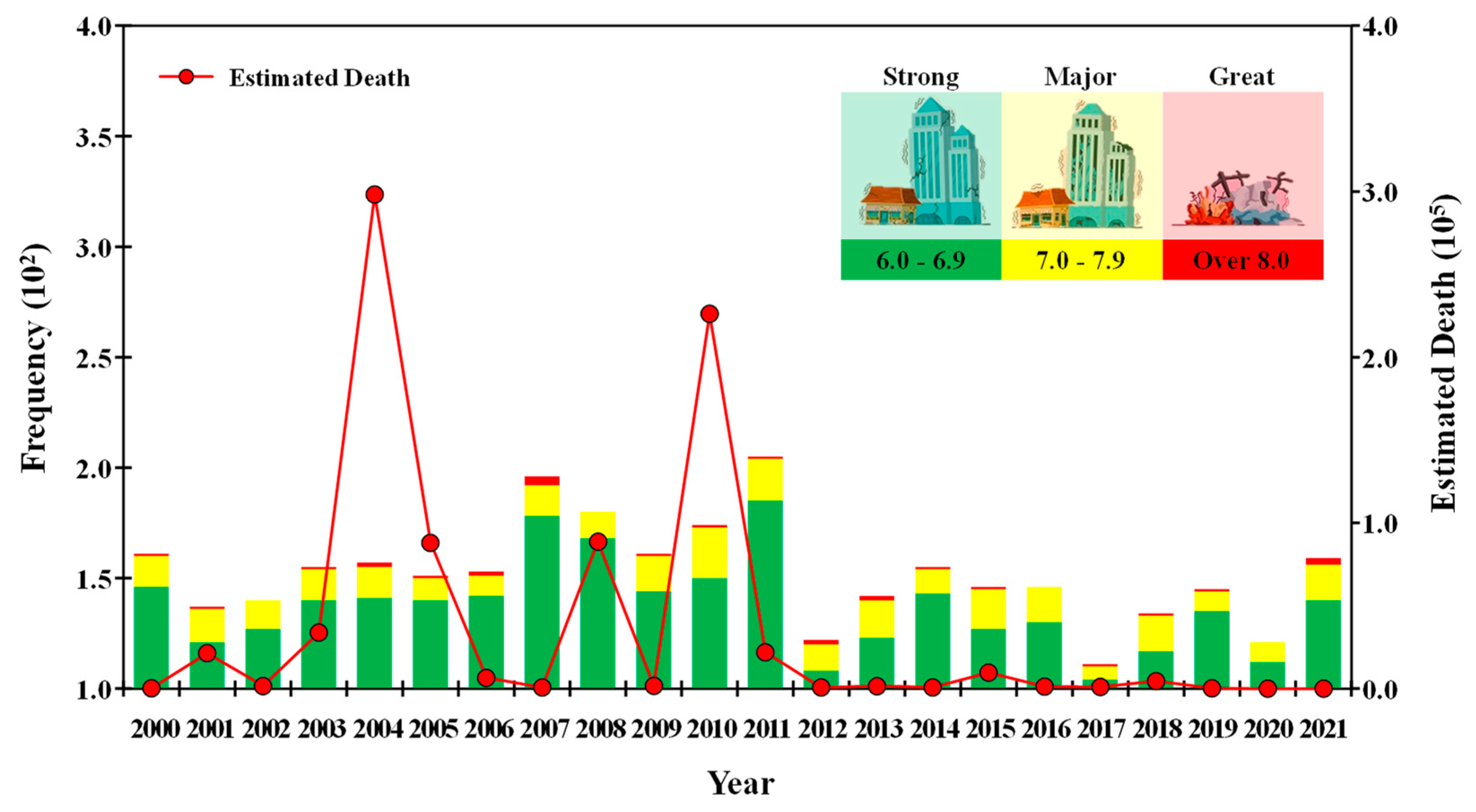





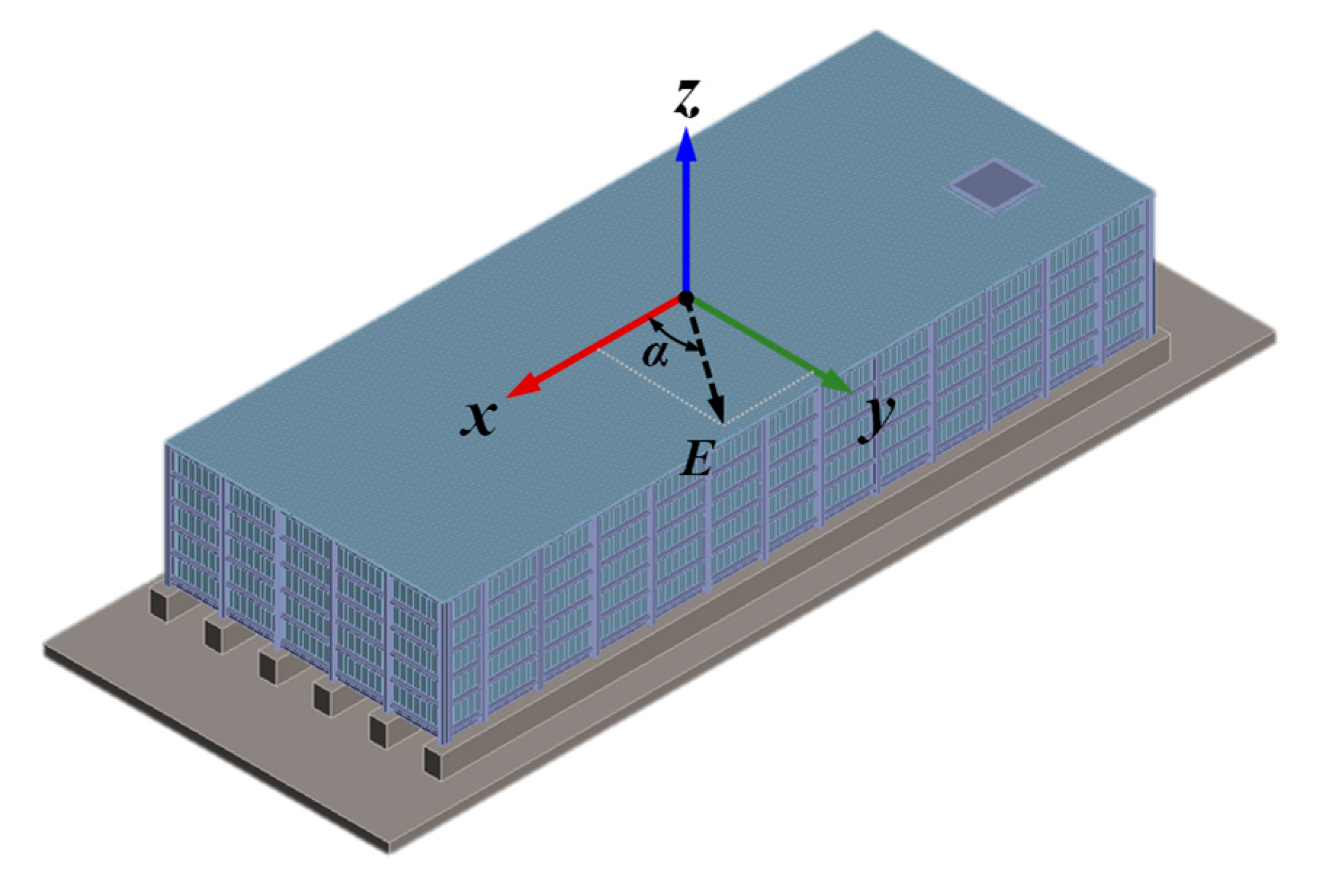
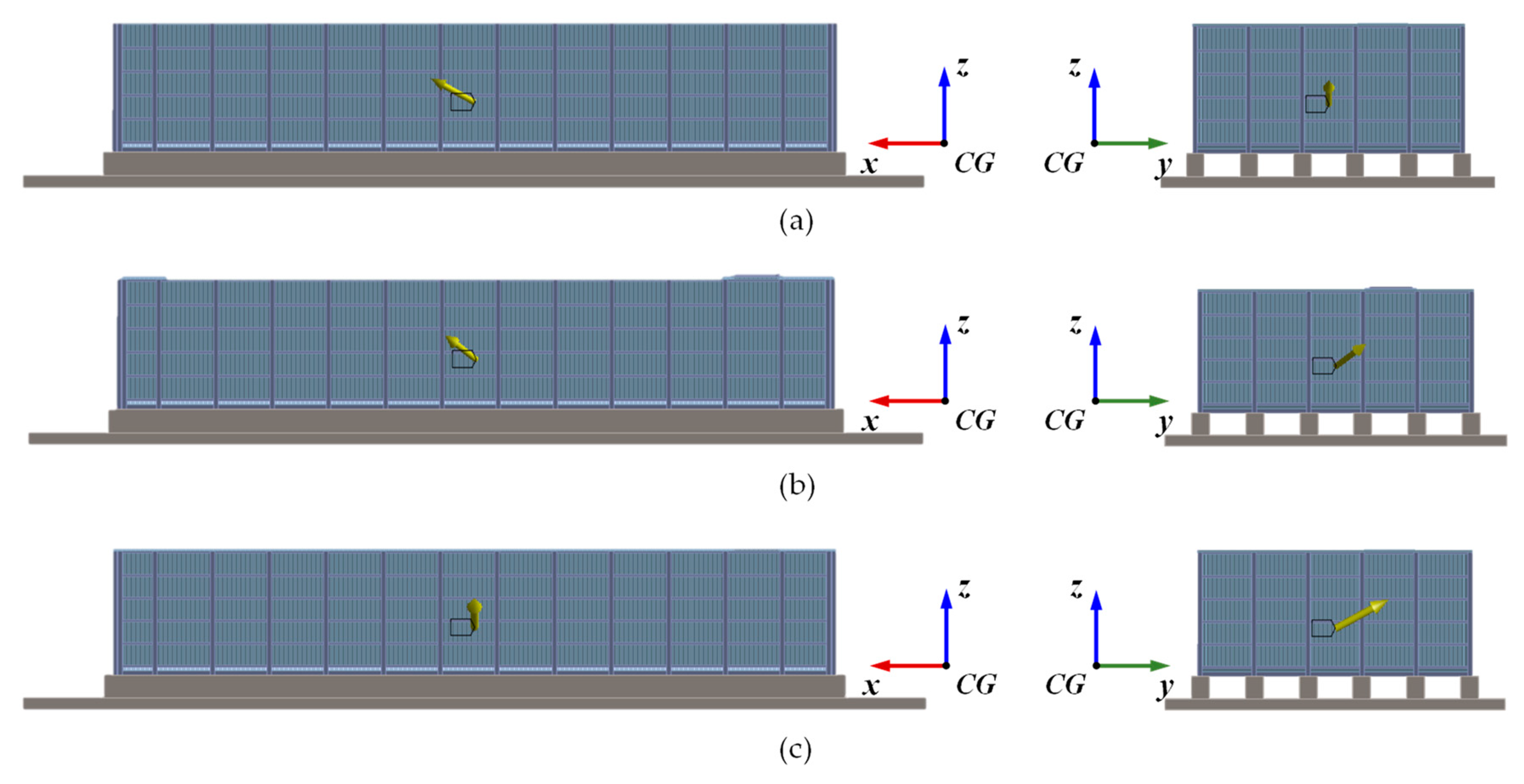
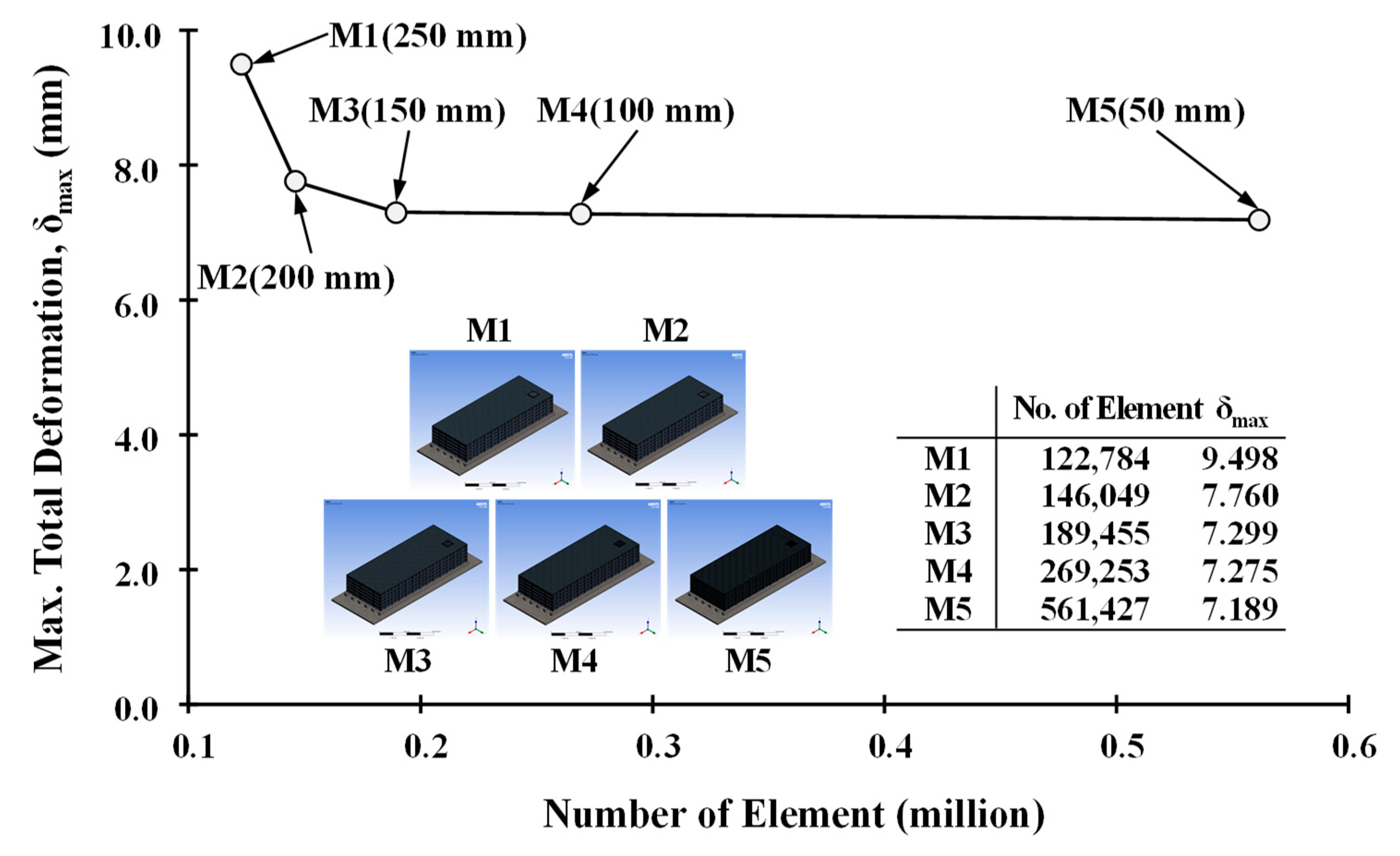
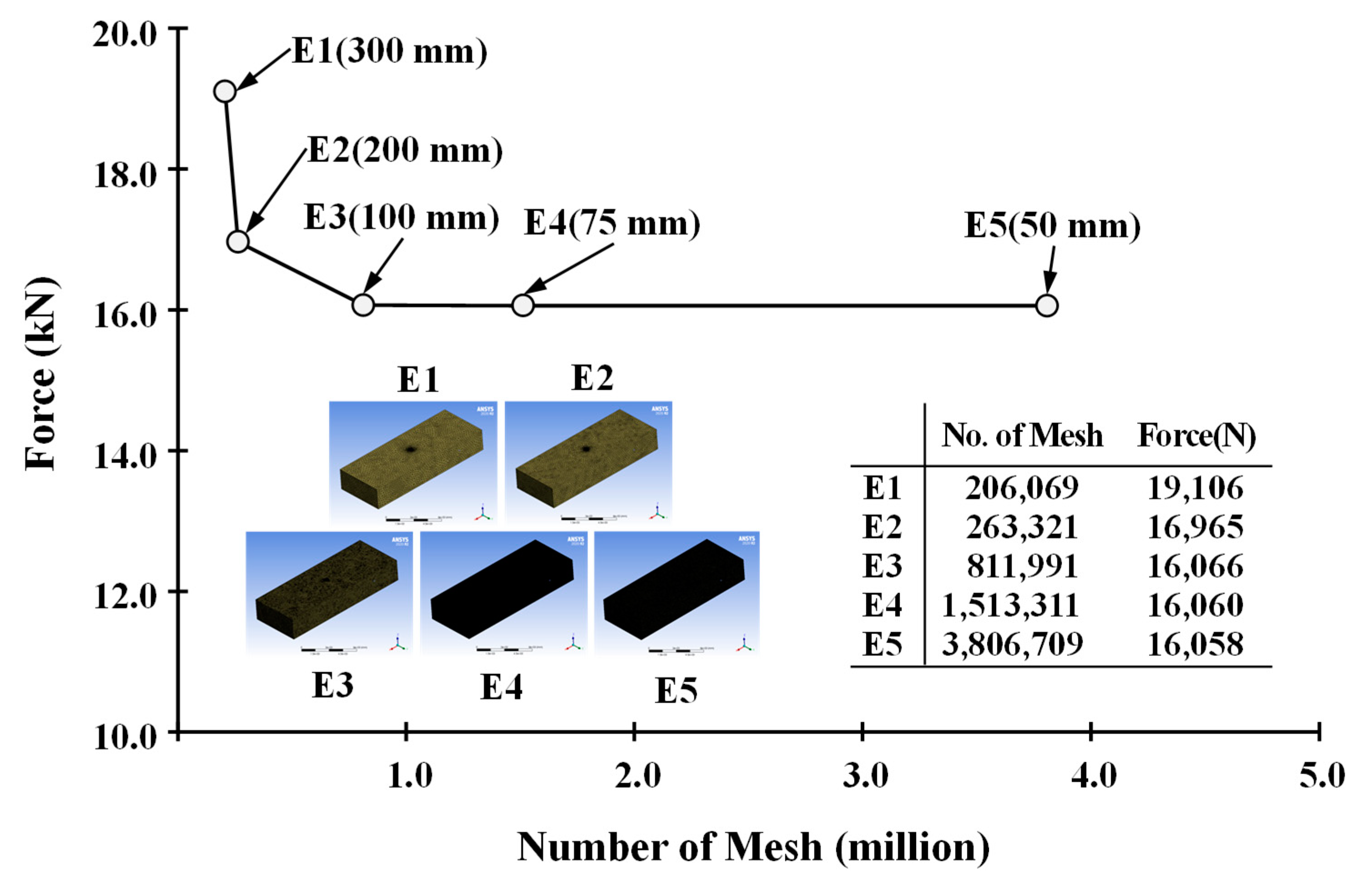

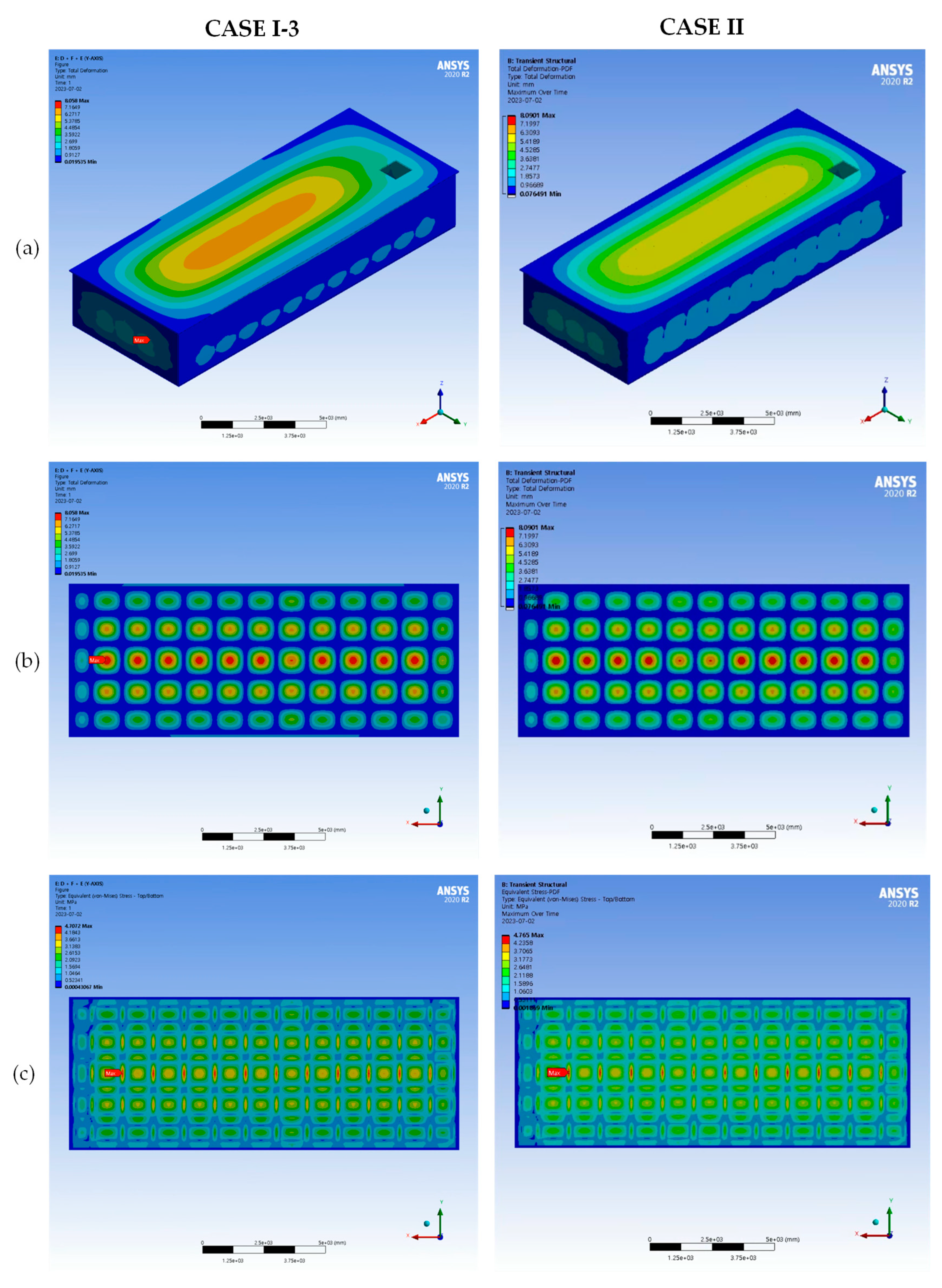
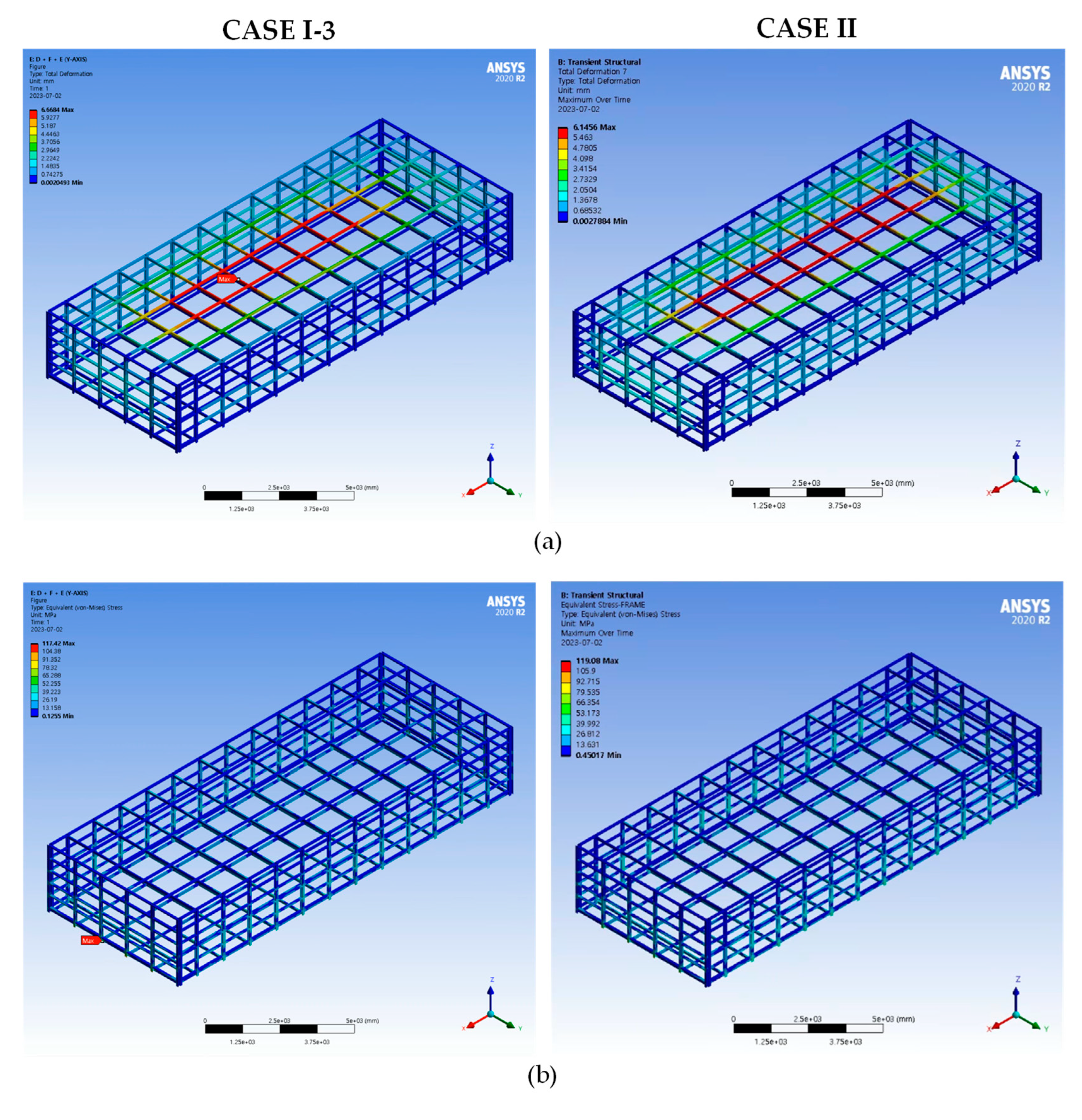

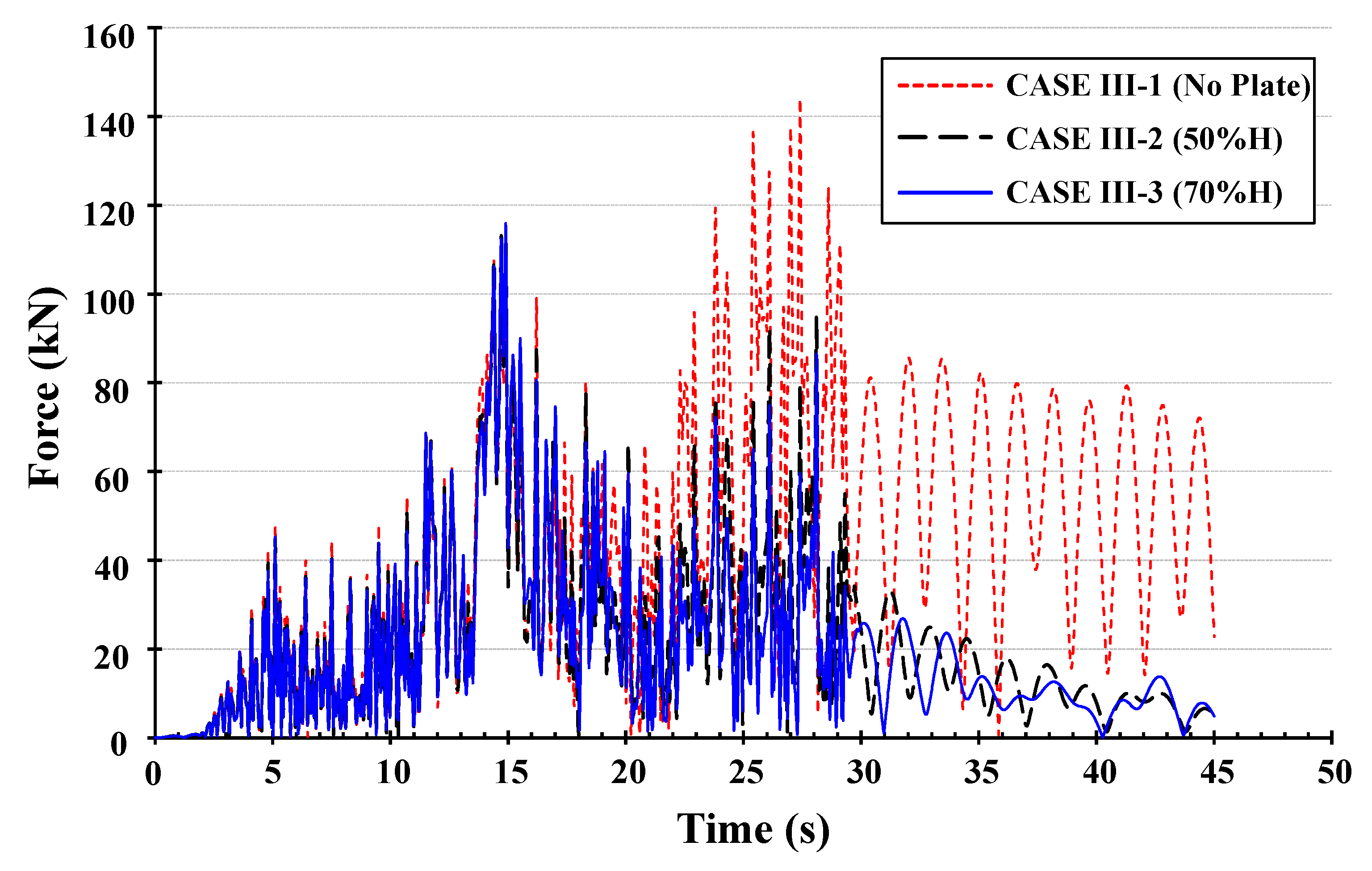


| Case | Structure | Fluid | Anti-Wave Plate | |||
|---|---|---|---|---|---|---|
| Static | Transient | No Plate | 50%H | 70%H | ||
| CASE I-1,2,3 | ■ | ■ | ||||
| CASE II | ■ | ■ | ||||
| CASE III-1 | ■ | ■ | ■ | |||
| CASE III-2 | ■ | ■ | ■ | |||
| CASE III-3 | ■ | ■ | ■ | |||
| Material | Density (kg/m3) | Modulus of Elasticity (MPa) | Poisson’s Ratio (−) | Yield Strength(MPa) | Ultimate Strength (MPa) |
|---|---|---|---|---|---|
| Concrete | 2300 | 30,000 | 0.18 | - | 24 |
| PDF Panel | 980 | 1100 | 0.42 | 25 | 33 |
| Carbon Steel | 7850 | 200,000 | 0.30 | 250 | 460 |
| Load Case | Factor (-) | (deg) | Load (g) | |
|---|---|---|---|---|
| CASE I-1 | x-axis | 1.5 | 0.0 | 0.3540 |
| y-axis | 1.5 | 0.0000 | ||
| z-axis | 0.8 | 0.1888 | ||
| CASE I-2 | x-axis | 1.5 | 45.0 | 0.2440 |
| y-axis | 1.5 | 0.2440 | ||
| z-axis | 0.8 | 0.1888 | ||
| CASE I-3 | x-axis | 1.5 | 90.0 | 0.0000 |
| y-axis | 1.5 | 0.3540 | ||
| z-axis | 0.8 | 0.1888 | ||
| Case | Item | Concrete Foundation | PDF Panel | Steel Beam Frame | |
|---|---|---|---|---|---|
| CASE I-1 (No Plate) | Total Deformation (mm) | 0.028 | 8.056 | 6.595 | |
| von Mises Stress (MPa) | 8.883 | 4.761 | 110.970 | ||
| Shear Stress (MPa) | XY-Plane | 0.594 | 0.785 | 25.228 | |
| YZ-Plane | 1.695 | 1.466 | 40.429 | ||
| ZX-Plane | 1.469 | 0.311 | 35.760 | ||
| CASE I-2 (No Plate) | Total Deformation (mm) | 0.028 | 8.057 | 6.631 | |
| von Mises Stress (MPa) | 8.731 | 4.745 | 112.100 | ||
| Shear Stress (MPa) | XY-Plane | 0.586 | 0.774 | 23.922 | |
| YZ-Plane | 1.694 | 1.466 | 37.589 | ||
| ZX-Plane | 1.469 | 0.312 | 36.599 | ||
| CASE I-3 (No Plate) | Total Deformation (mm) | 0.027 | 8.058 | 6.668 | |
| von Mises Stress (MPa) | 8.397 | 4.707 | 117.420 | ||
| Shear Stress (MPa) | XY-Plane | 0.567 | 0.779 | 23.227 | |
| YZ-Plane | 1.693 | 1.466 | 35.695 | ||
| ZX-Plane | 1.469 | 0.313 | 38.363 | ||
| Case | Item | PDF Panel | Steel Beam Frame | |
|---|---|---|---|---|
| CASE II (Transient, No Plate) | Total Deformation (mm) | 8.090 | 6.146 | |
| von Mises Stress (MPa) | 4.779 | 119.080 | ||
| Shear Stress (MPa) | XY-Plane | - | 24.089 | |
| YZ-Plane | - | 40.425 | ||
| ZX-Plane | - | 38.739 | ||
| Case | Item | PDF Panel | Steel Beam Frame | |
|---|---|---|---|---|
| CASE III-1 (1-way FSI, No Plate) | Total Deformation (mm) | 14.971 | 7.268 | |
| von Mises Stress (MPa) | 8.810 | 228.780 | ||
| Shear Stress (MPa) | XY-Plane | - | 50.049 | |
| YZ-Plane | - | 83.310 | ||
| ZX-Plane | - | 76.143 | ||
| CASE III-2 (1-way FSI, 50%H) | Total Deformation (mm) | 12.481 | 5.622 | |
| von Mises Stress (MPa) | 7.556 | 183.040 | ||
| Shear Stress (MPa) | XY-Plane | - | 36.514 | |
| YZ-Plane | - | 62.819 | ||
| ZX-Plane | - | 61.154 | ||
| CASE III-3 (1-way FSI, 70%H) | Total Deformation (mm) | 12.479 | 5.367 | |
| von Mises Stress (MPa) | 9.462 | 179.140 | ||
| Shear Stress (MPa) | XY-Plane | - | 38.640 | |
| YZ-Plane | - | 67.177 | ||
| ZX-Plane | - | 59.614 | ||
Disclaimer/Publisher’s Note: The statements, opinions and data contained in all publications are solely those of the individual author(s) and contributor(s) and not of MDPI and/or the editor(s). MDPI and/or the editor(s) disclaim responsibility for any injury to people or property resulting from any ideas, methods, instructions or products referred to in the content. |
© 2023 by the authors. Licensee MDPI, Basel, Switzerland. This article is an open access article distributed under the terms and conditions of the Creative Commons Attribution (CC BY) license (https://creativecommons.org/licenses/by/4.0/).
Share and Cite
Lee, S.-E.; Lee, D.-M. Development of Numerical Modelling Techniques for a Firefighting Water Tank with an Anti-Wave Plate under Seismic Loads. Appl. Sci. 2023, 13, 11689. https://doi.org/10.3390/app132111689
Lee S-E, Lee D-M. Development of Numerical Modelling Techniques for a Firefighting Water Tank with an Anti-Wave Plate under Seismic Loads. Applied Sciences. 2023; 13(21):11689. https://doi.org/10.3390/app132111689
Chicago/Turabian StyleLee, Sang-Eui, and Dong-Myung Lee. 2023. "Development of Numerical Modelling Techniques for a Firefighting Water Tank with an Anti-Wave Plate under Seismic Loads" Applied Sciences 13, no. 21: 11689. https://doi.org/10.3390/app132111689






